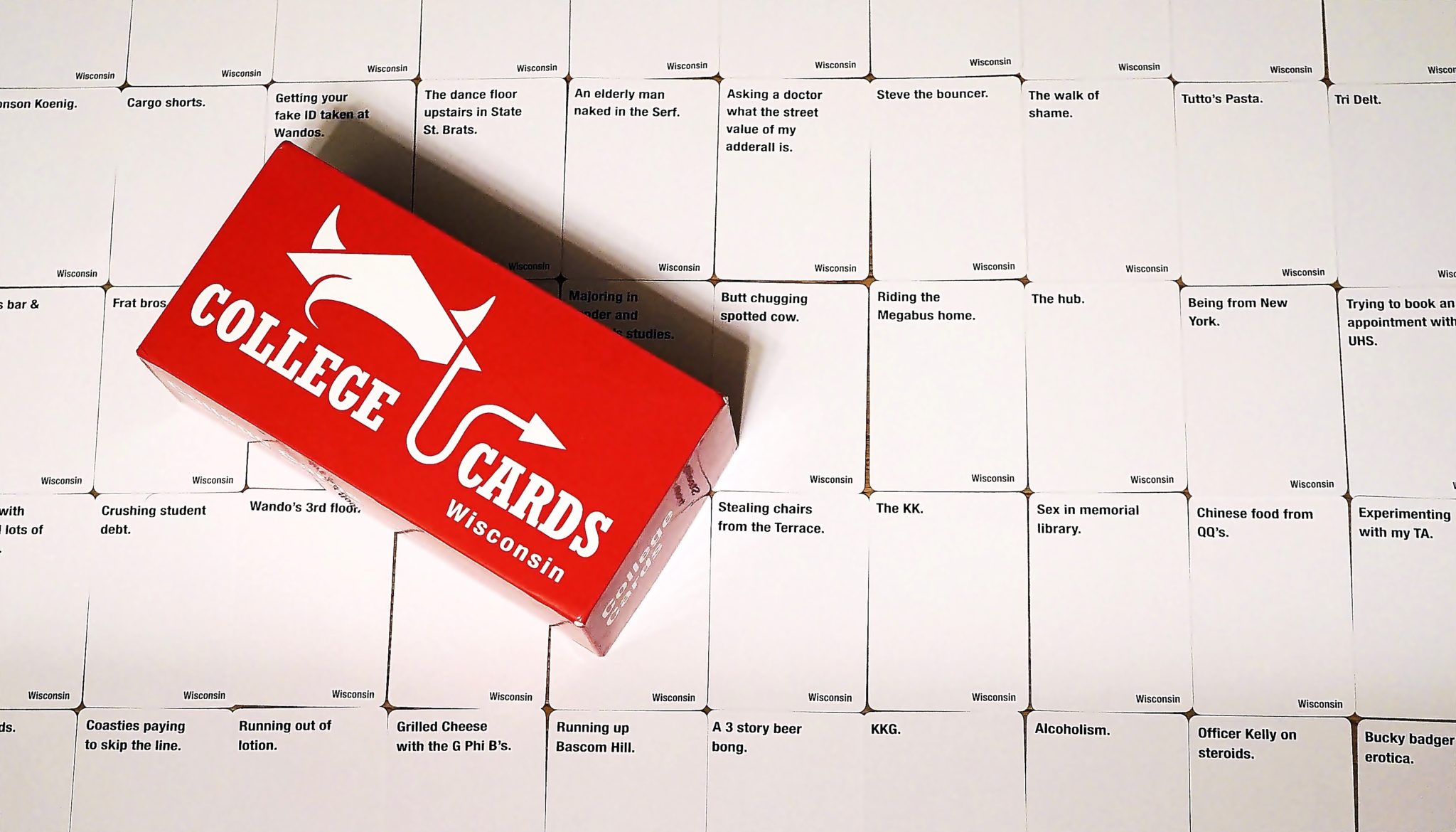When I was 22, I started a college campus focused card game called College Cards that was a knock-off of the popular party game Cards Against Humanity.
In 9 months, I went from idea, to game creation, to Chinese manufacturing, to distribution, to launch, to completely going viral at the University of Wisconsin—selling more than $13,000 of the game.
Then I got sued and lost it all.
Without a doubt, this was one of the best things that ever happened to me. Below, I tell the detailed story of exactly how I did it.
—
The Beginning
In June of 2017 I came across a Kickstarter campaign that was focused on launching a Harry Potter version of Cards Against Humanity.
I thought it was really clever.
From my perspective, I saw how the game could tap into two already huge audiences: people familiar with the raunchy, hilarious game of Cards Against Humanity, as well as the adoring, borderline obsessive Harry Potter fans.
The demand and virality for this product would essentially be baked in. Friends would share the game with the people they grew up watching and reading Harry Potter with. They’d tag each other in Facebook posts, send each other funny card combinations, and make other friends sit down and play the game with them at parties. It was immediately clear to me that the product could become a viral thing.
Stumbling across this idea and its ‘virality’ component really got my entrepreneurial mind turning.
In a few days, I came to the conclusion that the Cards Against Humanity game concept truly gets more fun the more ‘hyper-local’ and focused that it is. The more hyper-local you could get the game to be, the more you could tap into an existing audience by putting a raunchy spin on concepts that everyone in the same hyper-local community could relate and reminisce with.
This seemed like a homerun idea to me, and I became obsessed with it back in 2017. I decided that the ULTIMATE hyper-local community for this type of spin on Cards Against Humanity was…
Large college campuses and Universities.
Just imagine!
People would get to relive the nostalgia of college by playing the card game. Puking your guts out in the freshman dorms, getting your fake ID taken at that run down bar that even high schoolers got into, failing Organic Chemistry because you frankly have better things to be doing with your life, football games, roommates, finals, greek life, the list goes on and on and on.
All of these memories would get to be played out within the card game by the very people who lived them.
I was obsessed with the idea.
So, in July 2017, I decided that I was going to create a University of Wisconsin (my alma mater) version of Cards Against Humanity and call it: College Cards.
I didn’t know it then, but I would go on to sell more than $13,000 of “College Cards” decks in two short months before I was shut down, threatened with lawsuits by the University of Wisconsin, forced to destroy all inventory, and incur thousands of dollars of personal losses.
Man, what a thrilling adventure it was!
Honestly, looking back, it was one of the best things that ever happened to me. It set me up to pursue the “entrepreneurial” path. It helped me realize that you don’t have to work a traditional 9-5 for your whole life. It showed me the magical powers of the internet. Ultimately, it was the reason I would go on to build a new company that does hundreds of thousands of dollars in revenues every year and is 10X more valuable and successful than College Cards could have been.
But more on that later…
Below is a breakdown of EXACTLY how I created, launched, distributed, and sold College Cards. I hope it inspires you to do something unique or chase your own business venture.
Figuring Out How To Make It
It happens to everyone.
You come up with this awesome, amazingly-freakin’ cool idea. You’re excited about it. You know it’s going to be big. You then set out to go and make the idea a reality, and what happens? You hit a brick wall, and you ask yourself, “Wait, how the hell do I actually do this?”
I asked the same thing, “how the hell do I make a card game?” It’s not like I was trying to do something super crazy like build a robot or a rocket or something super technical, but still, where do you start?
Thankfully, the trick to getting past this brick wall is extremely simple.
Just start Googling the shit out of your problem.
Literally type into Google, “How do I manufacture a card game” or whatever your starting point is. Read everything and just keep Googling the things you need to learn about.
This is exactly what I did, and I quickly figured out that I simply needed to find a company that could manufacture the game for me.
Easy enough right?
I started Googling “Companies that manufacture card games”, and then for all the legit looking companies, I’d send out a cold email and ask for a quote on how much they’d charge to manufacture 50 versions of a card game.
My reasoning was that I first wanted to run a test and see if I could actually sell these games before putting down a serious amount of money. 50 decks seemed like a great amount for testing the idea to see if people would actually pay money for it.
During this research phase, I also figured out the company that actually manufactures the real Cards Against Humanity game. I hit them up and ended up getting referred to the CAH people themselves. They politely told me that they would not manufacture my game, but they also let me know that they do indeed allow other companies to build games off of their concept as long as it’s not branded and created to look exactly like the OG Cards Against Humanity.
This was great. Because of this news, I figured that I was set for building a copy-cat version of the game from a legal standpoint (lol) because the CAH people told me I was all good.
Unfortunately my nice little 50 version test-run turned out to be completely impossible, and the absolute MINIMUM that any manufacturer would print was a run of 500 copies. Out went the hope for ‘testing the market’. If I was going to do this, I was going to have to go all in.
Manufacturing costs also turned out to be a big issue.
I thought I’d be able to produce the game for 2-10 dollars a pop, but at such a low order quantity (500) the games were going to run me about $15 a piece to produce.
This was problematic. At $15 per deck to get the game to my door in Austin, TX, I didn’t have a ton of margin to work with after factoring in shipping and logistics, creating an eCommerce site, and other costs.
I ultimately decided it could still work.
My thesis was that if this thing was successful, I would be able to expand into the 100 largest college campuses across the nation. Scaling the amount of decks I’d order overtime would drop the cost of manufacturing—or so I thought. Turns out this thesis was COMPLETELY wrong, but I still went for it.
I ended up going with a manufacturer based in Shenzhen, China.
They gave me the cheapest quote.
I found them through another company based in Chicago from all my Googling and cold emails. The Chinese manufacturer would charge me $7,500 to produce 500 versions of my game. Do-able.
Keep in mind, at this time in my life I had just graduated college and was pretty broke, so it was a lot of money to me. I couldn’t front it all myself.
So I did what a lot of other people would do and called my Dad.
After a few days of convincing and pitching my idea and very rough business plan to him, we agreed that we would each put up $5,000 for the production run, $10,000 total. His $5,000 was a loan that I’d have to pay back with 7% interest in one years time. If I went out of business, I’d still have to find a way to pay him back. Tough love.
But hey, I had $10,000.
I was in business baby.
Creating The Game
Okay, the fun part.
While I was doing all of the research figuring out how I could physically get the product made, I was also making the card ideas and the content of the game deck in the bedroom of my apartment and in coffee shops all around Austin, TX.
My approach was easy. I went to school at Wisconsin for four years. I knew everything about that school and had lived my college experience to the fullest. So I started writing the content myself for the game.
I went out and bought a copy of the original Cards Against Humanity (I didn’t even have one at the time), and I counted how many cards it had in the deck: 550. 90 Black question cards, and 460 white content cards.
I copied the same model for my game, and I wrote over 500 card ideas over 2 months and kept the entire game in a Google spreadsheet. I also started recruiting some friends to help write content at this time.
The goal was to make the game as raunchy and inappropriate as possible as I knew this would lead to insane word of mouth and viral sharing on social media. The more outrageous, inappropriate, and jaw-dropping I could make the content, the more decks I would sell.
After two months, the game was done. Now, I needed to find someone who could design it.
Hiring A Designer
This part wasn’t hard. My manufacturer that I found through all the Google searches explained to me how the specs of the game had to be from a digital graphics standpoint.
So I went to UpWork and hired a freelance graphic designer who would put all of my card ideas from the Google Sheet onto a digital card design. She also designed the box.
I got the College Cards logo made on Fiverr for $20. Easy.

Once I got all of the designs together, I submitted everything and wired the $7,500 to the Chinese company and crossed my fingers. I didn’t get any samples from them as I couldn’t afford it. I was simply going on their word.
I had a 90 day lead time to wait for my games to be manufactured and shipped back to me on a freighter from China. I set my tentative launch date for the third week of November, 2017.
Building A Distribution and Marketing Strategy
So, the game was officially ordered and entering the manufacturing process.
With the 90 day lead time, I had three months before my 500 decks were set to get back to the US—plenty of time to build out what would be my marketing and sales strategy for the game.
My favorite framework for thinking about distribution/sales channels for any type of product is based on the strategies laid out in the book Traction by Gabriel Weinberg. The book breaks down just about every possible sales channel you can use to sell a product. Looking holistically across all sales channels then, you drill down into what 3 channels you believe will work best for your specific product or service. It’s a phenomenal book.
The key is that not all traction channels will work the same across every product and every company. So you need to quickly identify which will be the most effective for your product/service.
Using this approach, I guessed that the most effective traction channels for building College Cards into a viral product would be as follows:
- Content Marketing – primarily through shareable content on a College Cards Instagram account
- Email Marketing
- Paid Social Advertisement
This was my focus at the time. If I were to do it all over again, I would have done things differently and probably focused more on influencer marketing on Instagram. But at the time, I wanted to run everything super lean and not have to really pay for much of my marketing. Influencer marketing is crazy effective, but it can be a bit difficult to scale up.
I’ll break down how I specifically approached each of these channels in the run up to the launch below.
Content Marketing
Content marketing is a pretty broad term used by digital marketers.
In the case of College Cards, I wanted to be very focused on creating shareable Instagram content that UW students would end up tagging their friends in. If done effectively, this would bring immense exposure to the game at essentially zero cost. The content had to be funny, clever, and get people a little riled up so that they’d want to tag their friends.
The first step here was getting the Instagram account off the ground, and I used a bunch of growth hacks to do this.
To start, I bought 500 instagram followers for the account. You can buy insta followers simply by Googling “buy instagram followers”. It might have costed me $10 at the time.
I’m not sure if people realize just how fake the world of Instagram today is, but you’re about to find out.
I decided that it was important for the account to look like it had a large following before the game was officially released so that as I drove traffic to the page during the launch, it would look like people were already buzzing and playing this crazy, cool game because of this happenin’ instagram account. Good or bad, in the world of marketing, perception is reality.
Once I had my 500-ish fake followers, I started creating content for the account. Remember this is all before I’ve ever launched the game (October 2017 time frame), so the idea here was just to create a “pretty” page that would be ready for people to land on once I officially launched at the end of November.
I had also received the test run version of the game from my manufacturer at this time, so I was able to start making Instagram content with the actual cards.
Below are some pictures of that initial content.
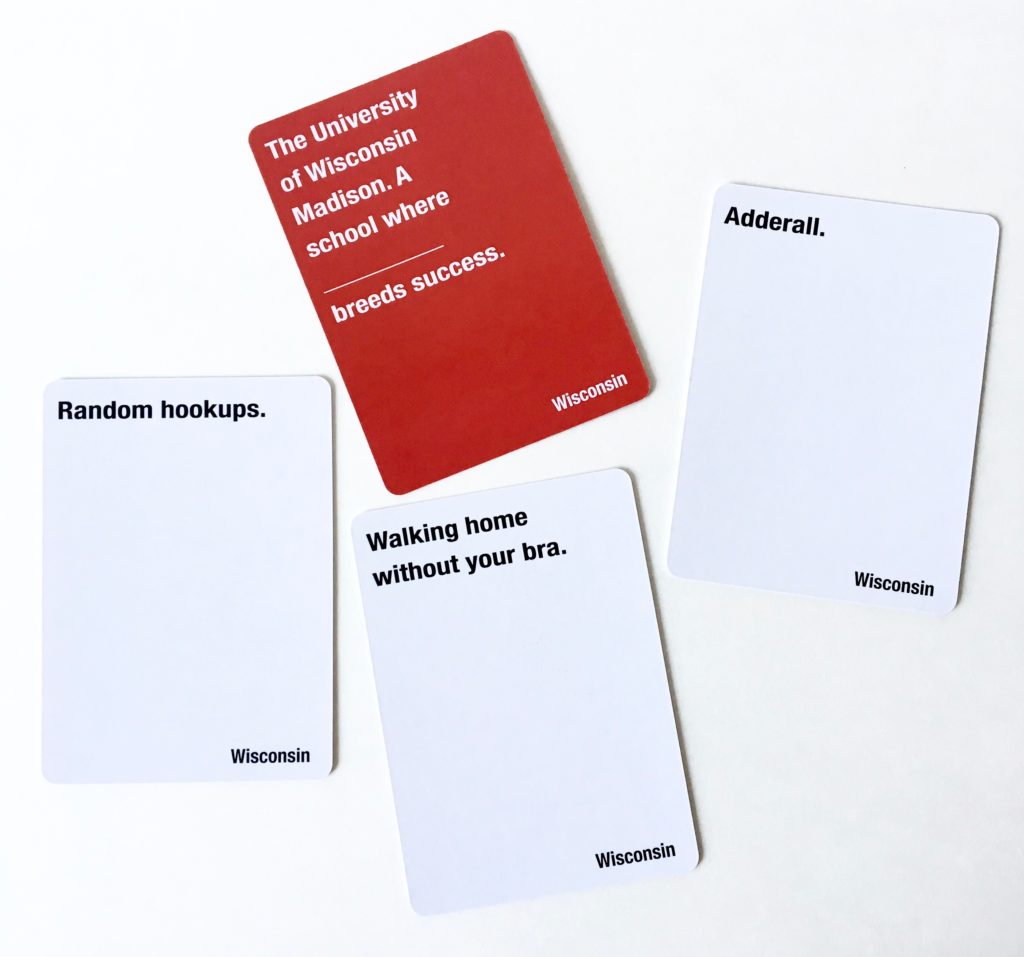
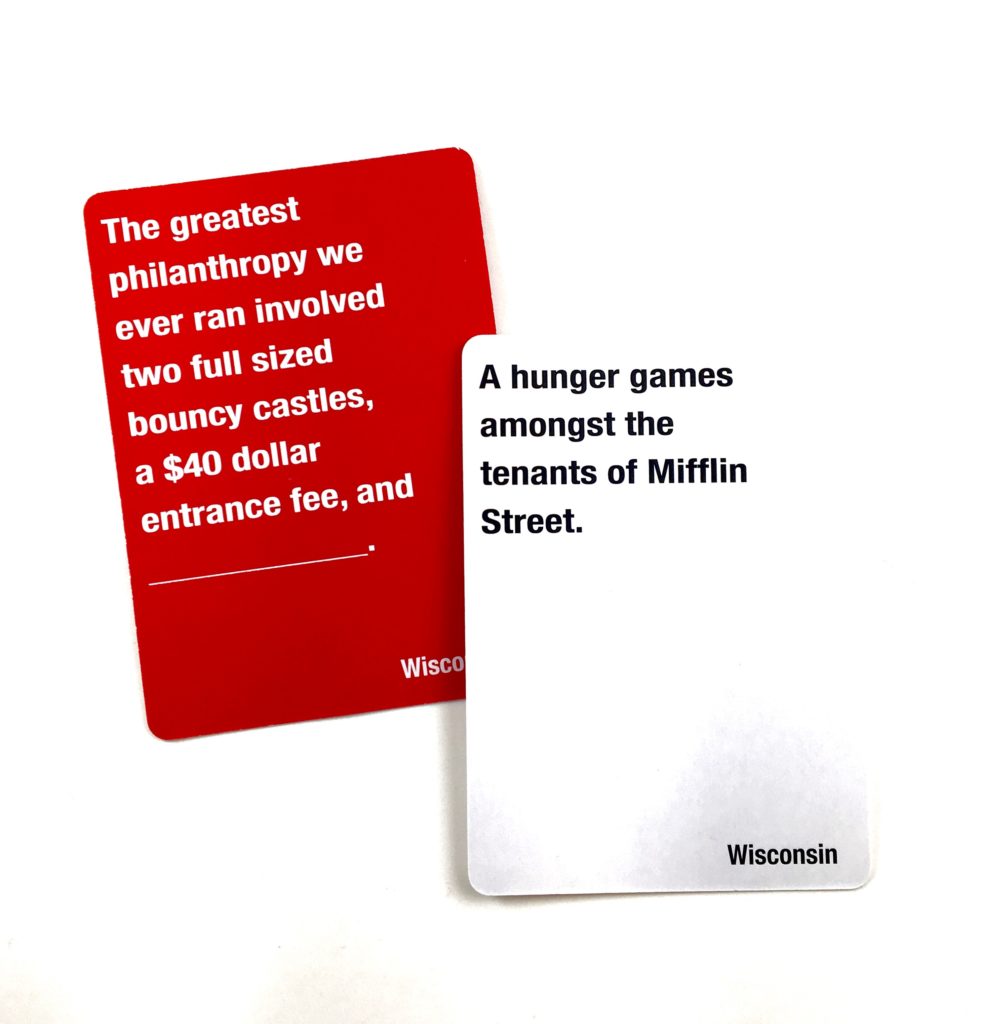

Remember, it was important to me that the account looked like it was super active, so simply having fake followers wasn’t enough in my eyes. I also needed to get some of that grade A fake engagement on the posts.
Again, it’s funny how fake the world of Insta is.
To get this fake engagement, I would post a picture (again, remember this is before I’ve even launched the game so no one important is actually seeing any of this yet) and then I’d go to Kylie Jenner’s instagram account and start commenting “LB” or “LBBB :))))” or “LB immediate” or “LB LB LB :D” on her most recent posts.
You might be asking yourself, “What the hell does LB mean?”
Well, let me tell you. It simply means “Like back”.
And by commenting on Kylie and Caitlin Jenner’s instagram account “LB” hundreds of times, I would get other phoney Instagramers to go to my College Cards instagram account and “Like” my photos so that I would hopefully go and “Like back” their photos in return.
This micro-economy of fake engagement is CRAZY on instagram, and there are literally millions of people doing this to hack the engagement of their posts. You can even comment things like “Comment back” or “CB :)” so that people will leave generic comments on your posts like, “Love <3” or “This is so inspirational :)”.
Insane, right?
I probably commented on Kylie Jenner’s instagram account over 2,000 times during my quest to build up the phoney College Cards instagram account. Although, I never actually returned the favor of liking anyone’s photos back. Oops.
So that was my process. I’d post a hilarious photo of a card combination, hack me some fake engagement, and then rinse and repeat until I had a beautiful Instagram page that had about 15-20 pieces of content that looked like they were all the rage.
The account was set.
Now, once I launched the game and sent hundreds and hundreds of real UW students to the account, it would look super legit, and they’d be much more prone to checkout the account, leave a comment, tag a friend, like one of the photos, and maybe even buy my game.
Email Marketing
Email marketing is insanely powerful. In the world of digital marketing, you’ll often hear that your email list is your most valuable asset.
I knew that if I could somehow get my hands on a list of Wisconsin student’s email addresses, I’d have a direct route straight to their inbox. As you can imagine, this would be very powerful for marketing a game that is specifically targeted towards these students.
Sadly, securing an email list of this sort was not as easy as I thought it might be.
Initially, I thought I’d be able to buy the email addresses. However, this turned out to be more difficult than I thought it would be.
After a ton of emailing and poking around, I gave up and couldn’t figure out how to outright buy an email list of all UW students.
But I wasn’t ready to give up on my golden email list. So I changed things up and decided to get creative…
During my years at Wisconsin, I worked a front desk job at one of the Freshman resident halls (shoutout Sellery Hall). In this job, we had to use the “Wisconsin directory” all the time to lookup student’s email addresses who hadn’t picked up their packages yet.
Because of this job, I knew that this directory would spit back an email address if you entered the name of a student. I decided I could use this directory to generate a database of Wisconsin student emails. The problem was that you needed to know the name of the student to get it to return the email address…
So, to get a list of student names, I joined the Facebook groups for all of the “Class of 20XX” Wisconsin groups.
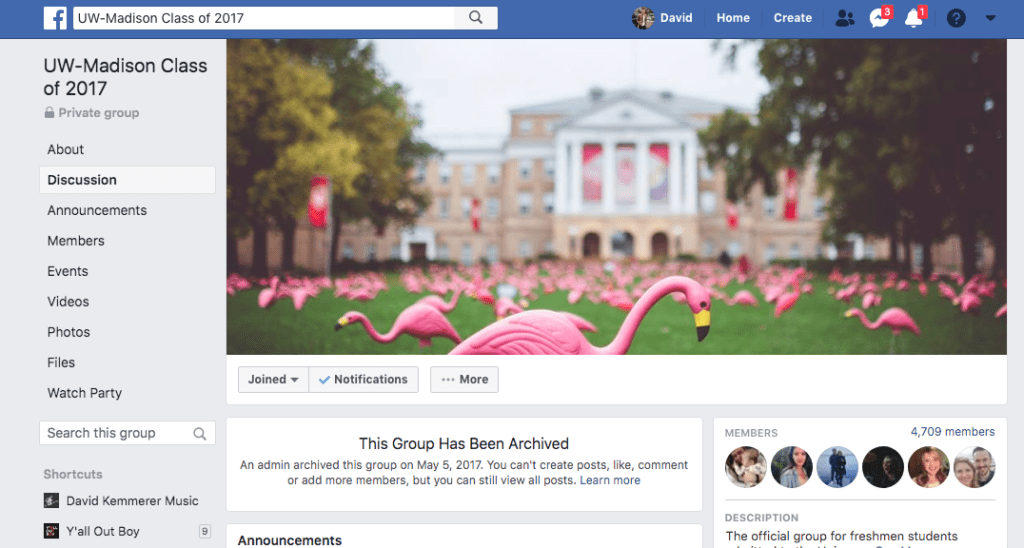
In these FB groups, you can openly see a list of all of the students that belong to the group who are presumably part of the “class of 2019” for example. For some reason the admins of these groups let me right in without noticing that I was no longer in college, and in-fact, not a member of the Class of 2019. Once I became a member of all of these UW Facebook groups, I had my list of thousands of UW students names right at my finger tips.
So again I took to UpWork and hired a freelancer in the Philippines to go through these Facebook group lists, punch in the names one by one into the UW directory, and put their email addresses into a Google spreadsheet that I gave him access to.
For $100, I built an email list of thousands of UW students that I’d be able to send an email to on the day of launch telling them all about my game.
Game on.
Paid Social Media
The final traction channel that I was planning to use was paid advertising on Facebook.
This channel was pretty amazing due to the nature of the card game. Again, because of the hyper-local audience that the game targeted, Facebook advertising provided an amazingly effective way to get in front of my exact audience.
I could make Facebook ads that would specifically target and only show my ads to University of Wisconsin Madison students who lived in Madison, Wisconsin and were between the ages of 18-24. The targeting capabilities of Facebook’s ad platform are truly second to none. This approach would allow me to spend small amounts of money extremely efficiently and drive all of those eyeballs to my website.
Oh, and I also wasn’t going to create boring product ads that explicitly promote the game. No, no, no. I was going to use a native advertising approach by promoting blog posts that I would write from the College Cards website like “the 10 most outrageous College Cards combinations for the University of Wisconsin” or “Why Steve the Bouncer is playing College Cards everyday”. This way the ads look like native content in your Facebook feed, and they are also interesting, entertaining pieces. This type of content gets a crazy amount of engagement and converts at a very high percentage.
I would literally spend maybe $10 on these ads to get thousands of engagements and hundreds of clicks through to my website where people would discover the game and ultimately buy themselves a copy.
These engagement levels were possible because my ads targeted my exact audience so efficiently.
The Launch
So my marketing plan was set. I had my distribution channels. I had a plan. And I believed this thing could go viral if I executed everything effectively.
The rest of my time running up to the launch was spent building the website for the game on WIX (this was a mistake and I should have used Shopify from the get-go) and setting up my Amazon seller account along with my Fulfillment By Amazon account which would handle all of the logistics and actual shipping/handling of the product.
If you are not familiar with FBA, essentially how it works is that you send them your inventory, and then they handle the shipping and handling of your products every time an online order comes in. This would allow me to focus on running the business rather than having to constantly go to the post office to fulfil orders. Nice.
After three long months, I finally received all 500 copies of the game. They were dropped off on a pallet in front of my then apartment. The property managers weren’t all that happy with me when the semi-truck pulled up…
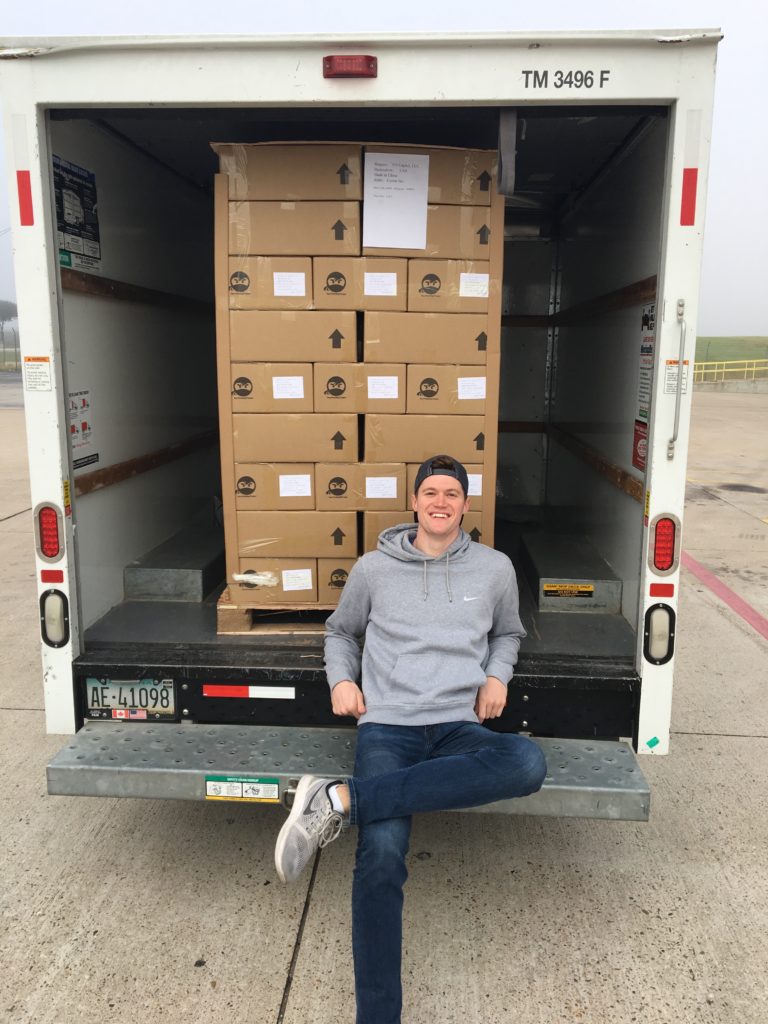
Alas, the time had come to officially launch my game into the world. And on December 12th, 2017, I took the day off from work to execute the plan.
I immediately set the Instagram plan into motion. I texted everyone I knew from Wisconsin and had them post pictures of the game on their Insta stories tagging the @CollegeCards instagram account. I blasted out an email to the thousands of students that were on my email list database telling them about the launch of the game. I posted a bunch of content on Facebook and boosted some with paid advertisements.
The game was launched, and the traffic it generated was insane.
My phone completely blew up that day. Non-stop texts, instagram messages, and notifications. I sold almost 80 decks at $29.99 a pop that very first day generating over $2,000 in revenue.
Over the next 8 weeks, the game was everywhere. I was being interviewed by local UW student newspapers, @CollegeCards was being tagged multiple times everyday by students on instagram, the UW bookstore wanted to put in an order to buy hundreds of copies of the game, and there was a general buzz on campus about this new outrageous Cards Against Humanity-Esque game specifically built for the University of Wisconsin.
Over the next 8 weeks, I sold more than 400 copies of the game generating more than $13,000 in revenue. It was so surreal. 9 months prior to this it was just an idea in my head. Going from idea to actually seeing hundreds of real students playing and absolutely loving this game that I created was exhilarating.
Everything was going great. That is until I received this letter from the law firm that represents the University of Wisconsin.
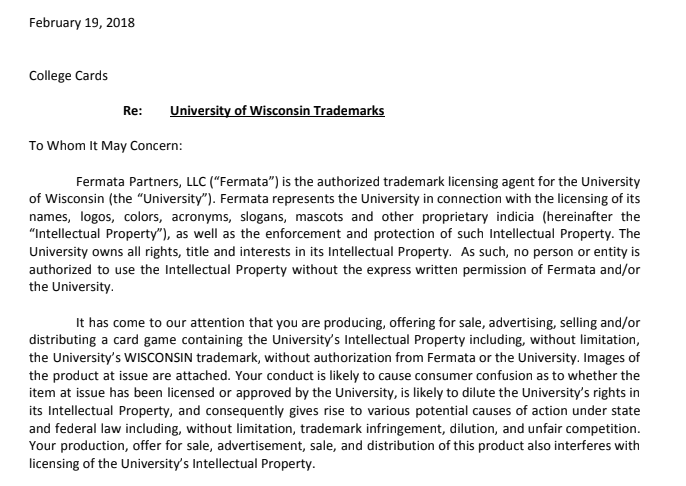
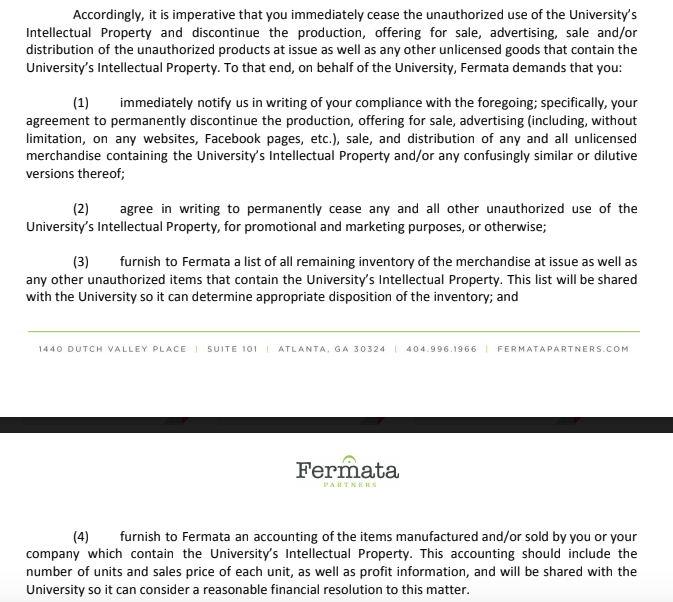
The Legal Dispute
Just re-reading that letter makes me sick to my stomach.
Essentially, the University was demanding that I “Cease and desist” all aspects of the game due to trademark infringement—even though the game does not explicitly use any UW-Madison owned trademarks which can be found here.
I was aware of how trademark infringement works prior to setting out to make the game. This is why I did not explicitly use any of the registered trademarks of UW in the game.
However, UW was coming after me despite this and were claiming that the game in and of itself is associating itself with the University (which is true) and that this would require it to become licensed with the UW trademark office.
UW would not let me continue to operate without getting a license from them and then pay a royalty on every deck sold.
So, I went to them to do this.
Turns out they were not willing to grant me a license due to the content and explicit nature of the game. So what does that mean? Well, according to them, I was infringing on their intellectual property and needed to get a license from them. If I didn’t get a license to sell the product, they could sue me for trademark infringement. However, they weren’t willing to even give me a license at all. So essentially they were forcing me to shut down all operations and gave me no alternative options to continue the business.
Unfortunate.
I faced tremendous amounts of pressure from their legal team during this time, and after weeks of wrestling with this reality, I had to give in.
I gave them an accounting of all profits I had made, destroyed all remaining inventory, and signed a legally binding affidavit all to avoid going to court.
When I officially announced the shutdown of College Cards, the local papers were all over it. It was a sad time, and I ended up losing somewhere around $15,000 in total in the venture.
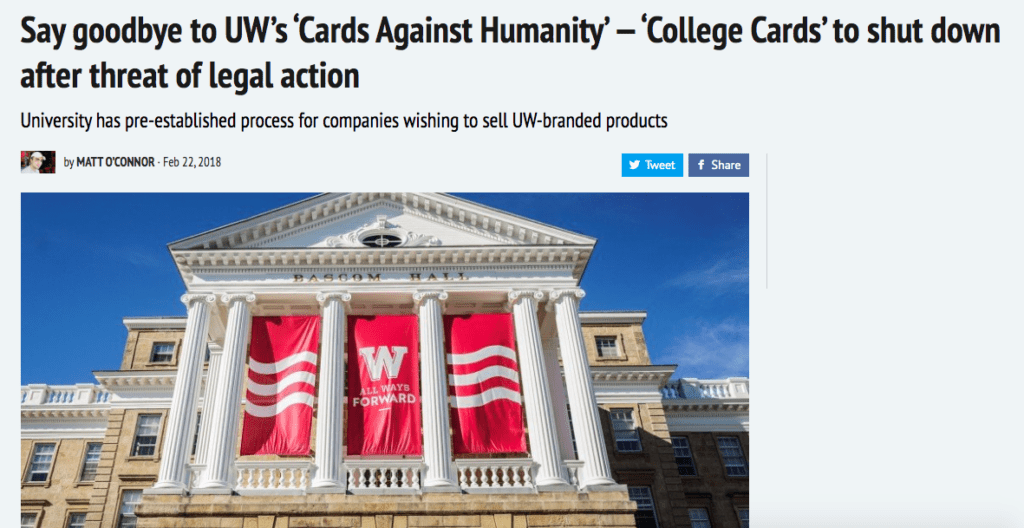
The Aftermath
The whole legal process sucked a lot, and it was really tough to swallow. Even writing this and reflecting on what happened almost two years ago gives me flashbacks…
The company that I had worked day and night to build for 9 months was done. I lost money. There was seemingly no profitable way forward. On top of that, this game and this thing had become my identity. It was what I did. It was how I envisioned my future. I was going to expand to the top 100 schools in the nation and build a multi-million dollar company in the card game space. When that vision gets taken away from you, you kind of go through a mini identity crisis.
I remember watching this video clip from the epic scene in Rocky over and over again during this time:
“It ain’t about how hard you can hit. It’s about how hard you can get hit and keep moving forward—how much you can take and keep moving forward.”
Cheesy as it is, I completely switched my mentality a couple weeks after the aftermath of shutting everything down. I made the decision that this wasn’t the end. I decided that I was going to bounce back, no matter what it took. This wasn’t going to be my entrepreneurial resume for life.
I have College Cards and Fermata partners to thank for this mindset. This legal battle turned out to be on of the best things that ever happened to me.
—
Two Years Later
Two years later, I’ve gone on to build a software-as-a-service company that helps people do their cryptocurrency taxes.
In our first full year in business, we have done hundreds of thousands of dollars in revenue, have helped more than 10,000 cryptocurrency users automatically build their necessary crypto tax reports, and have even partnered up with some of the biggest names in tax software like Intuit TurboTax to bring cryptocurrency tax reporting into the mainstream.
I’m going to be telling the story of how we built CryptoTrader.Tax in future blog posts here. I’m also going to be sharing my most successful marketing strategies, tips for other entrepreneurs, lessons learned along the way, and a whole lot more. If you’re interested in entrepreneurship, digital marketing, freedom, and ultimately ditching your 9-5, I’d encourage you to subscribe to my email list below. I’ll send you all of my secrets.
So that’s the story of College Cards! I hope you enjoyed it and learned a thing or two. Better yet, I hope this has got you thinking about a new venture that you can go out and start.
